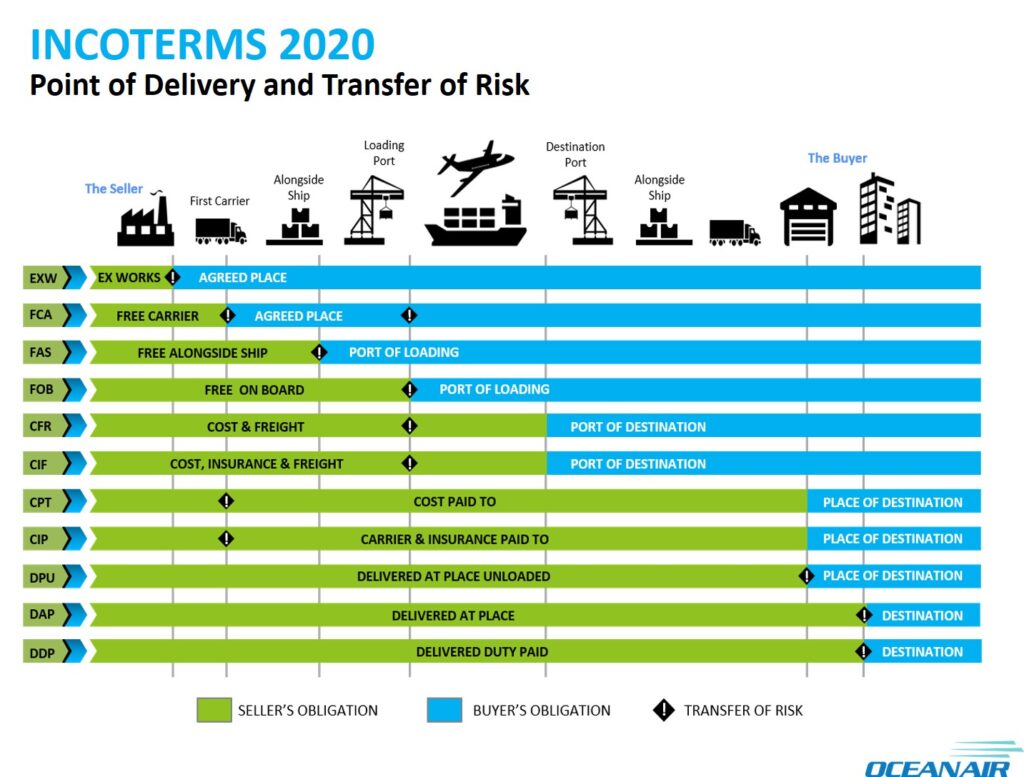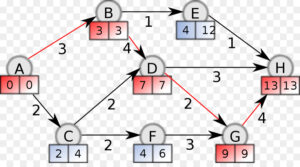Sooner or later, you will have to learn them. And usually, you will use only one or two, depending on your industry and/or location. Still, you need to know the basics. Especially where are the dangers. The rules and regulations of international transport in three letters – Incoterms.
So, what are Incoterms? They are created about 100 years ago, precisely in 1936. The organization that is issuing the Incoterms is the International chamber of commerce. Their page is in the sources area if you would like to dig deep into the topic. Also, below you can see the latest 2020 edition of the Incoterms. Save this picture on your computer, you will need it.
First, the official definition.
“Incoterms®” is an acronym standing for international commercial terms.”
“Incoterms®” is a trademark of the International Chamber of Commerce, registered in several countries.”
” The Incoterms define the basic rules of trade and are worldwide accepted.”

When you look at the picture, it looks quite simple. The seller is responsible for the delivery until one point, where the buyer takes over. Well, Incoterms take care of the four main points in goods transportation:
- What are the duties of each stakeholder?
- Who needs to arrange permissions, documentation and is responsible for the insurance?
- Which part of the transportation is taken care of by each stakeholder?
- When the risk is passing from seller to buyer.
However, bear in mind that they regulate only the movement of items from the seller to the buyer. They do not serve to regulate pricing, payment, quality or anything else related to the seller-buyer relationship.
The latest Incoterms 2020 has 11 different rules. Seven of them can be applied for any type of transport, while the remaining four are reserved for shipment by boat, whether on rivers or sea.
Here are they, starting with the universal ones:
EXW – Ex Works
The seller only needs to have the goods ready for pickup. It is the buyer’s job to load them onto the vehicle and take care of the rest of the transport. Once the goods are out of the seller’s premises, they are no longer his concern.
FCA – Free Carrier
In the case of export, the seller will deliver the goods to the port (for sea transport) or the cargo terminal (in case of air freight), and do the export clearance. From there it is the buyer’s job to take care of international transport and import into the destination country.
If it is domestic transport the seller only needs to load the goods on the buyer’s vehicle. The buyer needs to organize transport.
CPT – Carriage Paid to
Here it is the seller who arranges transport. The seller as well takes care of the paperwork needed for export. But the risk of loss, theft or damage is with the buyer during the transportation. While in domestic transport this may not be an issue, it is not the best choice for shipping.
CIP – Carriage and Insurance Paid To
The significant difference between CPT and CIP is that the seller now bears also insurance costs for the cargo until the final destination of the goods.
DAP – Delivered at Place
If this Incoterm is agreed upon, the responsibilities of the buyer are to pay for the customs clearance and duties in the country of import. Furthermore, he needs to arrange to unload goods at the point of destination. Everything else is done by the seller.
DPU – Delivered at Place Unloaded
Here the seller is responsible as well for the unloading of the goods at the place specified by the buyer. The one thing the buyer needs to do is to pay for the customs fees and taxes. The logistics of the goods movement is completely run by the seller
DDP – Delivered Duty Paid
This is my favourite. The seller takes care of everything. Import/export documentation and fees, transportation, unloading. The buyer has no obligations whatsoever until the goods are on his premises. In some countries it is not legally possible that the seller does the import, so check it out before signing the contract. As you may pay for the customs clearance twice, to the seller and then the customs office.
Marine transport is a bit more complicated compared to land or air transport. Therefore, we have a couple more specific Incoterms for this kind of transport. Also, all Incoterms for marine transport talk in more detail about export and import duties. As it is by default international transport.
The Incoterms that are related to marine transport are:
FAS – Free Alongside Ship
The seller should clear the export documentation and deliver the goods to the port, ready to be loaded onto the ship. From there the buyer takes over. The buyer will hire the shipment, arrange to load and import the goods. This term is used mostly for non-containerized shipments, like sand, oil etc.
FOB – Free on Board
Here the seller must assure the goods are loaded onto the ship nominated by the buyer. So, besides the export clearance, he still bears the risk of damage while the goods are in the port. Once the goods are safely stored on the ship, the buyer is the one responsible for all risk.
CFR – Cost and Freight
Moving forward, now the seller takes care of sea transport. Once the ship reaches the final destination, it becomes the responsibility of the buyer. The buyer needs to arrange to unload at the port, pay customs fees and arrange documents and transport to the final destination.
CIF – Cost Insurance and Freight
This is quite similar to CFR. The main difference is that the seller must arrange insurance for the goods to cover all risks until the final port of destination.
These are only the basic details. Please do not make any decisions before going into details about the offered incoterm. Incoterms are binding for both parties in the trade. So, if you make a wrong decision, it may cost you dearly.




Great infoarticle – sharing with my colleagues!
Glad You like it Sid!
This post was indeed very helpful ….Thank you so much !
Pingback: Do we need a lawyer? Contracts in procurement
I compared the details from different sites this one is much better.
Thank you,